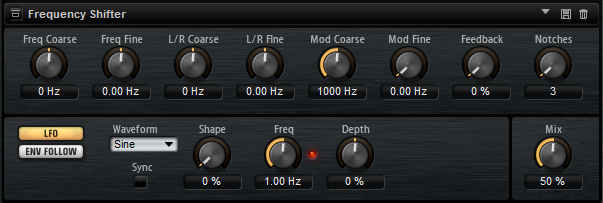Frequency Shifter
A frequency shifter shifts each frequency of the input signal by a fixed amount.

Unlike pitch shifters, which shift the frequencies by a factor, maintaining the harmonic relations, a frequency shifter alters the harmonic relations. Therefore, a larger frequency shift usually results in a disharmonic sound. Furthermore, a frequency shifter alters the frequencies by adding an offset, while a pitch shifter multiplies the frequencies by a factor. The frequency shifter alters lower frequencies more than higher frequencies. For example, if the input signal has the frequencies 100 Hz, 1000 Hz, and 10000 Hz and you shift the frequency by +100 Hz, the resulting frequencies are 200 Hz, 1100 Hz, and 10100 Hz.
- Freq Coarse
-
Sets the amount of frequency shift.
- Freq Fine
-
Allows you to fine-tune the amount of frequency shift.
- L/R Coarse
-
Sets an offset for the left and right channels.
-
Positive values shift the right channel upwards and the left channel downwards.
-
Negative values shift the left channel upwards and the right channel downwards.
-
- L/R Fine
-
Allows you to fine-tune the offset between the left and right channels.
-
Positive values shift the right channel upwards and the left channel downwards.
-
Negative values shift the left channel upwards and the right channel downwards.
-
- Mod Coarse
-
Sets the maximum amount of frequency shift via modulation from LFO and Envelope Follower.
- Mod Fine
-
Allows for fine-tuning of the amount of frequency shift via modulation from LFO and Envelope Follower.
- Feedback
-
Sets the amount of feedback, that is, the amount of signal that is sent from the output of the effect back to its input. The sound is similar to that of a phaser. You can control the direction and the speed of this effect with the Freq Fine parameter.
- Notches
-
Sets the number of notches the phaser effect produces when you use larger amounts of Feedback.
LFO Section
- LFO Wave Shape
-
Waveform selects the basic type of waveform. Shape changes the characteristics of the waveform.
-
Sine produces smooth modulation, suitable for vibrato or tremolo. Shape adds additional harmonics to the waveform.
-
Triangle is similar to Sine. Shape continuously changes the triangle waveform to a trapezoid.
-
Saw produces a ramp cycle. Shape continuously changes the waveform from ramp down to triangle to ramp up.
-
Pulse produces stepped modulation, where the modulation switches abruptly between two values. Shape continuously changes the ratio between the high and low state of the waveform. If Shape is set to 50%, a square wave is generated.
-
Ramp is similar to the Saw waveform. Shape adds a gradually increasing amount of silence before the sawtooth ramp up begins.
-
Log produces a logarithmic modulation. Shape continuously changes the logarithmic curvature from negative to positive.
-
S & H 1 produces random stepped modulation, where each step is different. Shape puts ramps between the steps and changes the S & H into a smooth random signal, with the control set fully to the right.
-
S & H 2 is similar to S & H 1. The steps alternate between random high and low values. Shape puts ramps between the steps and changes the S & H into a smooth random signal, with the control set fully to the right.
-
- Freq
-
Specifies the frequency of the LFO in Hertz.
- Sync
-
Activate this to set the Freq parameter in fractions of beats.
- Depth
-
Determines the direction and amount of frequency shift from the LFO modulation signal.
Envelope Follower
The Envelope Follower traces the input signal with an adjustable attack and release time and delivers a modulation signal representing the level envelope of the signal.
- Sensitivity
-
All input signals are mixed down to mono before they are sent to the Envelope Follower. This parameter sets the optimum input level for the Envelope Follower.
- Attack
-
Adjusts the attack time, that is, the time the Envelope Follower needs to approach increasing input levels.
- Release
-
Adjusts the release time, that is, the time the Envelope Follower needs to approach decreasing input levels.
- Depth
-
Determines the direction and amount of frequency shift from the envelope follower modulation signal.
NoteThe maximum frequency shift via modulation from LFO or the Envelope Follower is determined by the parameters Modulation Range Coarse and Modulation Range Fine.
- Mix
-
Sets the ratio between the dry and the wet signal.